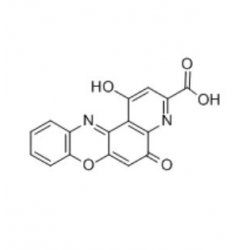




The highly advanced and precisely formulated Pirenoxine CAS 1043-21-6 we offer our customers are of popular brands known for consistently high quality. Pirenoxine CAS NO 1043-21-6 is also called Catalin and PRX that is widely used to anti-cataract. The mechanism of action of it is interacting with calcium and selenite ions to keep the eye lens, and to keep the vision clear. We can offer best service and effective delivery.
Thera. Category: anti-cataract agent
Cas No.: 1043-21-6
Synonym: 1-Hydroxy-5-oxo-5H-pyrido[3,2-]phenoxazine-3-carboxylicacid;Bernetine;catalin;PIRENOXINE;1-hydroxy-5-oxo-5h-pyrido[3,2-a]phenoxazine-3-carboxylic acid;1-Hydroxy-3-carboxy-5H-pyrido[3,2-a]phenoxazin-5-one;1-Hydroxy-5H-pyrido[3,2-a]phenoxazin-5-one-3-carboxylic acid;5H-Pyrido[3,2-a]phenoxazine-3-carboxylic acid, 1-hydroxy-5-oxo-

Molecular Formula: C16H8N2O5
Molecular Weight: 308.25
Assay: ≥97.%
Packing: Export worthy packing
Material Safety Data Sheet: Available on request
Usage: Catalin (Pirenoxine) CAS 1043-21-6 is an anti-cataract agent used to inhibit the development of cataracts in patients considered at risk. Its mechanism of action is interacting with calcium and selenite ions, which are known to play a central role in the formation of lens cataracts. This in turn can help stop crystals in the eye that are water soluble from insolubilization, which allows for the eye lens and vision to remain clear. Another medical study showed that it might be effective in helping preventing an oxidative attack on the eye lens, which could further explain its potential as a treatment for cataract prevention
